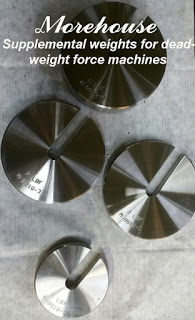Force Applications for Mass Reference Standards
Force Applications for Mass may create some confusion for those trying to convert the Conventional Mass of a mass reference standard to the True Mass. This blog post hopes to give you some simple solutions to calculate both True Mass (used in Force measurements) and Conventional Mass (typically used on weighing instruments).

Mass Definitions
M = True Mass of the artifact. The term “mass” is always used in the strict Newtonian sense as a property intrinsic to matter. This property is sometimes referred to as “true mass” or “mass in a vacuum” to distinguish it from the conventional (apparent) mass.
CM = Conventional Mass of the artifact. Conventional mass is defined as the mass of material of a specified density that would exactly balance the unknown object if the weighing were carried out at a temperature of 20 °C in an air of density 0.0012 g/cm3.
Density, Conversions, & Gravity
Air Density is typically in the range of 0.0011 g/cm3 to 0.0012 g/cm3.
- Equal Conversions: 0.0012 g/cm3 = 1.2 kg/m3 = 1.2 mg/cm3
Stainless steel weights (mass reference standards) typically have a material density in the range of 7.85 g/cm3 to 8.03 g/cm3.
- Equal Conversions: 8.0 g/cm3 = 8000 kg/m3 = 8000 mg/cm3
Cast iron weights (mass reference standards) typically have a material density close to 7.2 g/cm3.
- Equal Conversions: 7.2 g/cm3 = 7200 kg/m3 = 7200 mg/cm3
By international convention (recommendation) Weight Calibration Certificates typically report conventional mass values and/or conventional mass corrections.
Force Applications for Mass - Equations
Gravity corrections must be made to mass reference standards to be used in “force” applications. The conventional mass must be converted to the true mass before applying a gravity correction.

M = true mass of the weight (not to be confused with conventional mass)
g = local acceleration due to gravity, m/s2
d = air density (approximately 0.0012 g/cm3)
D = density of the weight in the same units as d (approximately 8.0 g/cm3)
Note: 9.80665 = the factor converting SI units of force into the customary units of force. For SI units, this factor is not used.
Generic Mass Equations
To Convert Conventional Mass to True Mass:

To Convert True Mass to Conventional Mass:

Force Applications for Mass Reference Standards - Conclusion
If you enjoyed this article, check out our LinkedIn and YouTube channel for more helpful posts and videos.
Everything we do, we believe in changing how people think about force and torque calibration. Morehouse believes in thinking differently about force and torque calibration and equipment. We challenge the "just calibrate it" mentality by educating our customers on what matters, and what causes significant errors, and focus on reducing them.
Morehouse makes our products simple to use and user-friendly. And we happen to make great force equipment and provide unparalleled calibration services.
Wanna do business with a company that focuses on what matters most? Email us at info@mhforce.com.
#Force Application for Mass


